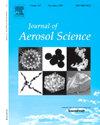Numerical simulation and experimental analysis of aerosol deposition: Investigating nozzle effects on particle dynamics and deposition
IF 3.9
3区 环境科学与生态学
Q2 ENGINEERING, CHEMICAL
引用次数: 0
Abstract
Aerosol deposition (AD), also known as vacuum kinetic spray (VKS), is used to deposit dense ceramic films onto a substrate surface at room temperature. One predominant factor influencing the overall deposition process is the nozzle geometry, which significantly impacts the quality, shape, and thickness of the coating. To evaluate the effect of nozzle geometry in AD, particle trajectory and impact velocity were investigated via computational simulation. A Eulerian-Lagrangian model was used to simulate the gas flow, particle in-flight behavior, as well as particle deposition characteristics on a flat substrate. Three common nozzle geometries in AD were utilized: a converging-diverging nozzle with a slit cross-section (CD-Slit), a converging-barrel nozzle with a slit cross-section (CB-Slit), and a converging-diverging round (CD-Round) nozzle. Moreover, suitable drag coefficient and Nusselt number correlations were used to account for compressibility and rarefaction effects on particle dynamics and heat transfer. The simulation results were compared to the deposition pattern obtained experimentally. The results demonstrate that shape of the nozzle has profound effect on the particle impact velocity and deposition pattern. The CD-Round nozzle provides uniform, thinner coatings ideal for extensive surfaces at a slower deposition rate. In contrast, the CB-Slit nozzle is optimized for maximum coating thickness in narrow, thick linear patterns. The CD-Slit nozzle achieves high deposition rates with uniform coatings and a distinctive cat-ear shaped pattern.
气溶胶沉积的数值模拟和实验分析:研究喷嘴对粒子动力学和沉积的影响
气溶胶沉积(AD)又称真空动力学喷雾(VKS),用于在室温下在基底表面沉积致密的陶瓷膜。影响整个沉积过程的一个主要因素是喷嘴的几何形状,它对涂层的质量、形状和厚度有很大影响。为了评估喷嘴几何形状在 AD 中的影响,我们通过计算模拟研究了粒子轨迹和冲击速度。我们使用欧拉-拉格朗日模型模拟了气体流动、粒子飞行过程以及粒子在平面基底上的沉积特性。模拟采用了 AD 中三种常见的喷嘴几何形状:具有狭缝截面的会聚-发散喷嘴(CD-Slit)、具有狭缝截面的会聚-桶形喷嘴(CB-Slit)和会聚-发散圆形喷嘴(CD-Round)。此外,还使用了适当的阻力系数和努塞尔特数相关系数,以考虑颗粒动力学和热传递的可压缩性和稀释效应。模拟结果与实验获得的沉积模式进行了比较。结果表明,喷嘴的形状对粒子撞击速度和沉积模式有深远影响。CD-Round 喷嘴能以较慢的沉积速度为大面积表面提供均匀、较薄的涂层。相比之下,CB-Slit 喷嘴经过优化,可在窄而厚的线性图案中实现最大涂层厚度。CD-Slit 喷嘴的沉积速率高,涂层均匀,图案呈独特的猫耳形。
本文章由计算机程序翻译,如有差异,请以英文原文为准。
求助全文
约1分钟内获得全文
求助全文
来源期刊

Journal of Aerosol Science
环境科学-工程:化工
CiteScore
8.80
自引率
8.90%
发文量
127
审稿时长
35 days
期刊介绍:
Founded in 1970, the Journal of Aerosol Science considers itself the prime vehicle for the publication of original work as well as reviews related to fundamental and applied aerosol research, as well as aerosol instrumentation. Its content is directed at scientists working in engineering disciplines, as well as physics, chemistry, and environmental sciences.
The editors welcome submissions of papers describing recent experimental, numerical, and theoretical research related to the following topics:
1. Fundamental Aerosol Science.
2. Applied Aerosol Science.
3. Instrumentation & Measurement Methods.
 求助内容:
求助内容: 应助结果提醒方式:
应助结果提醒方式:


